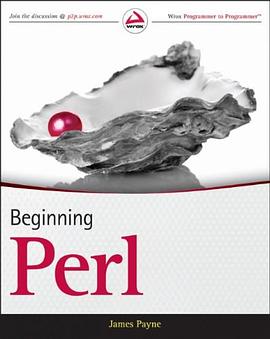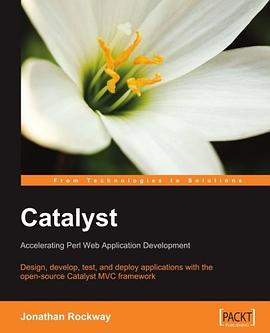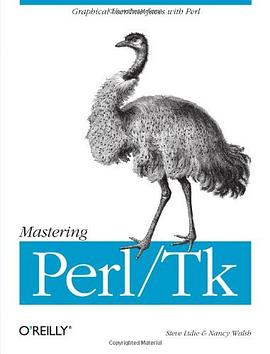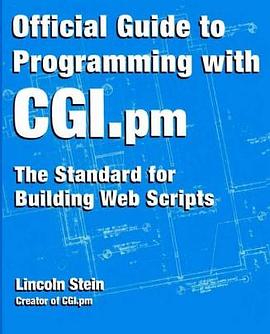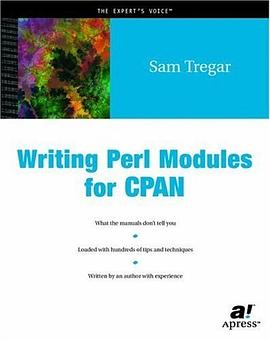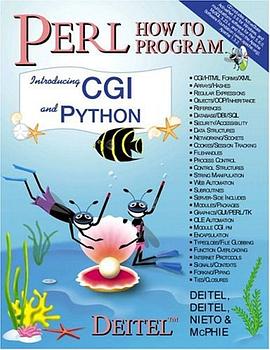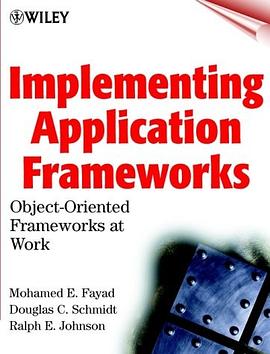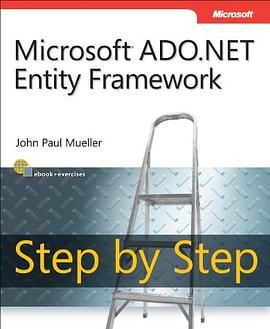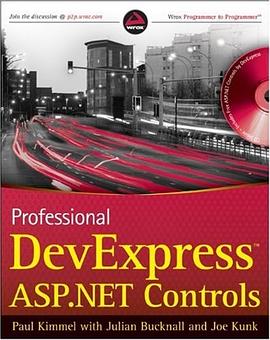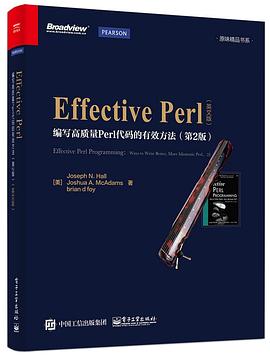
具体描述
《EffectivePerl:编写高质量Perl代码的有效方法(第2版)(英文版)》是Perl编程领域的“圣经”级著作。它提供了100多个翔实的应用案例,足以涵盖编程过程中经常遇到的方方面面,由此详细阐释出各种高效且简洁的写法。《EffectivePerl:编写高质量Perl代码的有效方法(第2版)(英文版)》第1版曾畅销十年之久,而在第2版中不仅修正了前版存在的一些问题,更与时俱进地引入了许多Perl领域的新主题,使内容更加完善丰富,也更具实用性。
《EffectivePerl:编写高质量Perl代码的有效方法(第2版)(英文版)》为初级Perl程序员铺就了一条通往高阶之路,而对高级Perl程序员而言,也是必备的技术参考书。
作者简介
Joseph N. Hall,自称“电脑神童”,一路玩着得州仪器的可编程计算器和配有 4KB 内存的 Radio Shack TRS-80 Model 1 长大。14 岁时第一次教授计算机课程。Joseph 拥有北卡罗来纳州立大学计算机科学学士学位,自 1984 年起开始以编程为生。他从 1987 年起开始使用 UNIX 和 C,自 1993 年以来一直在使用 Perl。他的兴趣涉及软件工具和编程语言、钢琴和电子琴,以及高尔夫。
Joshua A. McAdams 活跃于 Perl 社区已近 5 年。他创办了Perlcast,主持过两届在芝加哥的YAPC::NA,他为 Chicago.pm 举办会议,在世界各地的 Perl 会议上做过发言,是一位 CPAN 作者。这是他的图书处女作,不过此前已为 The Perl Review 和 Perl Advent Calendar 写过文章。至于日常工作,Josh 就职于 Google,在那里他的日常开发并不一定涉及 Perl,不过只要可能他就会 使用。
brian d foy 是《Perl 语言入门(第5版)》和 Intermediate Perl 的合著者,以及《精通 Perl》的作者。他发起了第一个 Perl 用户组 New York Perl Mongers,出版了 The Perl Review,维护着部分 Perl 核心文档,是一名 Perl 讲师,并常在大会上发言。
目录信息
前言
致谢
关于作者
Introduction
Chapter 1 The Basics of Perl
Item 1. Find the documentation for Perl and its modules.
Item 2. Enable new Perl features when you need them.
Item 3. Enable strictures to promote better coding.
Item 4. Understand what sigils are telling you.
Item 5. Know your variable namespaces.
Item 6. Know the difference between string and numeric comparisons.
Item 7. Know which values are false and test them accordingly.
Item 8. Understand conversions between strings and numbers.
Item 9. Know the difference between lists and arrays.
Item 10. Don’t assign undef when you want an empty array.
Item 11. Avoid a slice when you want an element.
Item 12. Understand context and how it affects operations.
Item 13. Use arrays or hashes to group data.
Item 14. Handle big numbers with bignum .
Chapter 2 Idiomatic Perl
Item 15. Use $_ for elegance and brevity.
Item 16. Know Perl’s other default arguments.
Item 17. Know common shorthand and syntax quirks.
Item 18. Avoid excessive punctuation.
Item 19. Format lists for easy maintenance.
Item 20. Use foreach , map , and grep as appropriate.
Item 21. Know the different ways to quote strings.
Item 22. Learn the myriad ways of sorting.
Item 23. Make work easier with smart matching.
Item 24. Use given-when to make a switch statement.
Item 25. Use do {} to create inline subroutines.
Item 26. Use List::Util and List::MoreUtils for easy list manipulation.
Item 27. Use autodie to simplify error handling.
Chapter 3 Regular Expressions
Item 28. Know the precedence of regular expression operators.
Item 29. Use regular expression captures.
Item 30. Use more precise whitespace character classes.
Item 31. Use named captures to label matches.
Item 32. Use noncapturing parentheses when you need only grouping.
Item 33. Watch out for the match variables.
Item 34. Avoid greed when parsimony is best.
Item 35. Use zero-width assertions to match positions in a string.
Item 36. Avoid using regular expressions for simple string operations.
Item 37. Make regular expressions readable.
Item 38. Avoid unnecessary backtracking.
Item 39. Compile regexes only once.
Item 40. Pre-compile regular expressions.
Item 41. Benchmark your regular expressions.
Item 42. Don’t reinvent the regex.
Chapter 4 Subroutines
Item 43. Understand the difference between my and local .
Item 44. Avoid using @_ directly unless you have to.
Item 45. Use wantarray to write subroutines returning lists.
Item 46. Pass references instead of copies.
Item 47. Use hashes to pass named parameters.
Item 48. Use prototypes to get special argument parsing.
Item 49. Create closures to lock in data.
Item 50. Create new subroutines with subroutines.
Chapter 5 Files and Filehandles
Item 51. Don’t ignore the file test operators.
Item 52. Always use the three-argument open .
Item 53. Consider different ways of reading from a stream.
Item 54. Open filehandles to and from strings.
Item 55. Make flexible output.
Item 56. Use File::Spec or Path::Class to work with paths.
Item 57. Leave most of the data on disk to save memory.
Chapter 6 References
Item 58. Understand references and reference syntax.
Item 59. Compare reference types to prototypes.
Item 60. Create arrays of arrays with references.
Item 61. Don’t confuse anonymous arrays with list literals.
Item 62. Build C-style structs with anonymous hashes.
Item 63. Be careful with circular data structures.
Item 64. Use map and grep to manipulate complex data structures.
Chapter 7 CPAN
Item 65. Install CPAN modules without admin privileges.
Item 66. Carry a CPAN with you.
Item 67. Mitigate the risk of public code.
Item 68. Research modules before you install them.
Item 69. Ensure that Perl can find your modules.
Item 70. Contribute to CPAN.
Item 71. Know the commonly used modules.
Chapter 8 Unicode
Item 72. Use Unicode in your source code.
Item 73. Tell Perl which encoding to use.
Item 74. Specify Unicode characters by code point or name.
Item 75. Convert octet strings to character strings.
Item 76. Match Unicode characters and properties.
Item 77. Work with graphemes instead of characters.
Item 78. Be careful with Unicode in your databases.
Chapter 9 Distributions
Item 79. Use Module::Build as your distribution builder.
Item 80. Don’t start distributions by hand.
Item 81. Choose a good module name.
Item 82. Embed your documentation with Pod.
Item 83. Limit your distributions to the right platforms.
Item 84. Check your Pod.
Item 85. Inline code for other languages.
Item 86. Use XS for low-level interfaces and speed.
Chapter 10 Testing
Item 87. Use prove for flexible test runs.
Item 88. Run tests only when they make sense.
Item 89. Use dependency injection to avoid special test logic.
Item 90. Don’t require more than you need to use in your methods.
Item 91. Write programs as modulinos for easy testing.
Item 92. Mock objects and interfaces to focus tests.
Item 93. Use SQLite to create test databases.
Item 94. Use Test::Class for more structured testing.
Item 95. Start testing at the beginning of your project.
Item 96. Measure your test coverage.
Item 97. Use CPAN Testers as your QA team.
Item 98. Set up a continuous build system.
Chapter 11 Warnings
Item 99. Enable warnings to let Perl spot suspicious code.
Item 100. Use lexical warnings to selectively turn on or off complaints.
Item 101. Use die to generate exceptions.
Item 102. Use Carp to get stack traces.
Item 103. Handle exceptions properly.
Item 104. Track dangerous data with taint checking.
Item 105. Start with taint warnings for legacy code.
Chapter 12 Databases
Item 106. Prepare your SQL statements to reuse work and save time.
Item 107. Use SQL placeholders for automatic value quoting.
Item 108. Bind return columns for faster access to data.
Item 109. Reuse database connections.
Chapter 13 Miscellany
Item 110. Compile and install your own perl s.
Item 111. Use Perl::Tidy to beautify code.
Item 112. Use Perl Critic.
Item 113. Use Log::Log4perl to record your program’s state.
Item 114. Know when arrays are modified in a loop.
Item 115. Don’t use regular expressions for comma-separated values.
Item 116. Use unpack to process columnar data.
Item 117. Use pack and unpack for data munging.
Item 118. Access the symbol table with typeglobs.
Item 119. Initialize with BEGIN ; finish with END .
Item 120. Use Perl one-liners to create mini programs.
Appendix A Perl Resources
Appendix B Map from First to Second Edition
Books
Websites
Blogs and Podcasts
Getting Help
Index
· · · · · · (收起)
读后感
评分
评分
评分
评分
用户评价
相关图书
本站所有内容均为互联网搜索引擎提供的公开搜索信息,本站不存储任何数据与内容,任何内容与数据均与本站无关,如有需要请联系相关搜索引擎包括但不限于百度,google,bing,sogou 等
© 2025 qciss.net All Rights Reserved. 小哈图书下载中心 版权所有



